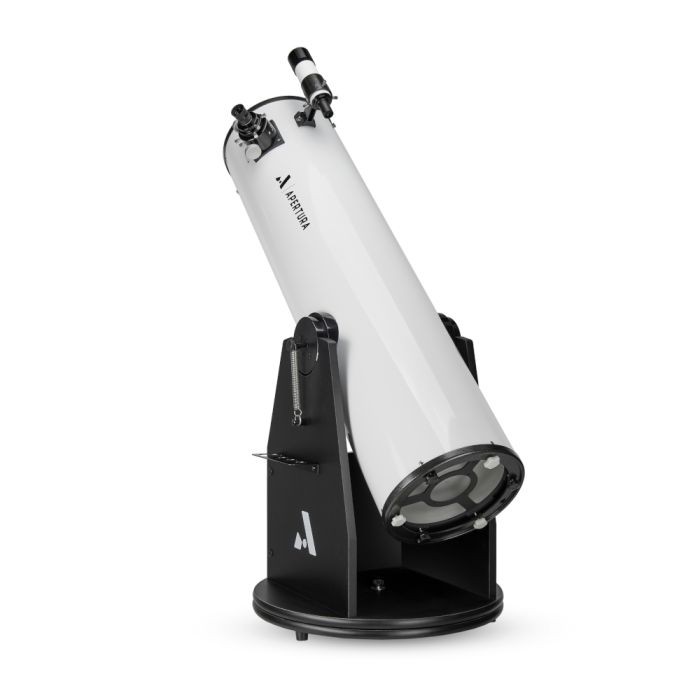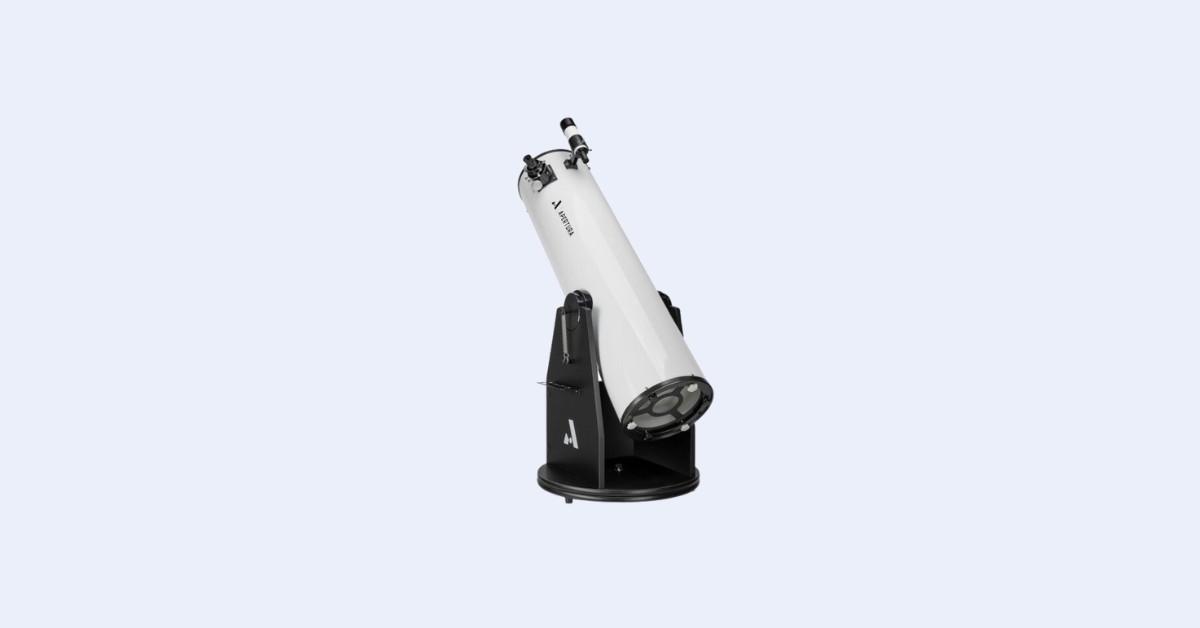The Optical Tube
The Apertura DT10 is a 10” (254mm) f/4.9 Newtonian reflector with a focal length of 1250mm. This is a pretty standard optical configuration among most 10” Dobs. At f/4.9, some coma is visible towards the edge of the field of view with wide-angle 2” eyepieces, but it’s debatable whether you’ll notice, let alone if it’s worth bothering with a coma corrector for. Good collimation is crucial (though not difficult) at f/4.9, and our collimation guide goes into detail on how to do it yourself as well as what tools you might want. The DT10’s primary mirror is adjustable for collimation without any tools; the secondary mirror is tilted with a hex key, but you should rarely have to adjust the secondary if at all.

The focuser that comes with the DT10 is GSO’s single-speed Crayford focuser. Instead of thumbscrews, it holds eyepieces in place with a brass compression ring. The Crayford focuser doesn’t use any gears or teeth but instead works by sliding a smooth metal drawtube against rollers; you can adjust the amount of friction to carry heavy eyepieces without slipping or lock the focuser in place too.
A single-speed focuser works just fine at f/4.9, but some swear by a dual-speed unit. The good news is that it’s easy to install a dual-speed upgrade onto the DT10’s focuser – or you can simply buy the more expensive AD10, which has this upgrade included by default.
The DT10’s tube, I find, is fairly easy to pick up and move at about 35 lbs., and it fits across the back of most vehicles.
Accessories
The Apertura DT10 comes with only a single eyepiece – a 1.25” 25mm Plossl providing 50x magnification. This Plossl has an apparent field of view of 52 degrees and well-blackened internals to keep internal reflections and glare to a minimum. However, 50x isn’t nearly enough magnification for small targets like planets and globular star clusters, and for low-power deep-sky viewing you’ll be rewarded by using a wide-angle 2” eyepiece. The included eyepiece fits into the DT10’s 1.25” adapter, which also uses a compression ring and is threaded for 2” filters to allow you to use 2” filters on your 1.25” eyepieces.
For a finder, a straight-through 9×50 magnifying finder scope is provided with the Apertura DT10. This finder has a field of view of around 6 degrees, similar to that of a pair of handheld 50mm binoculars, but with the field of view flipped upside down and crosshairs added. It can show stars a few magnitudes fainter than your naked eye alone, and even some bright deep-sky objects such as globular star clusters.
Mount
The Apertura DT10 uses a fairly standard Dobsonian mount. For azimuth (side-to-side) motion, the scope swivels on a laminate gliding against a set of three plastic pads (the more expensive AD10 uses roller bearings, which are quite controversial among users and unusual for a Dobsonian). To pivot in altitude (up/down), the DT10 uses plastic cylindrical bearings atop plastic pads.
The altitude bearings on the Apertura DT10 – and almost all consumer Dobsonians – are undersized, which can lead to balance issues when heavy accessories, such as a big eyepiece, are mounted on the front. To compensate for the too-light motions of the undersized bearings, the DT10 uses springs to pull the bearings tightly against the base and increase friction. This system works quite well. Even at 500x magnification, it’s easy to aim the DT10, and the balance stays the same with all but the heaviest eyepieces and accessories in the focuser.
As with most mass-market Dobsonians, you assemble the DT10’s base yourself with a hex key, much like IKEA furniture. The base is particle board and thus susceptible to damage, particularly from moisture, over time. Thankfully, building a replacement out of plywood is easy and inexpensive—a plywood base is also lighter and can be further optimized for weight with cutouts if you build one yourself.
On the side of the Apertura DT10’s base is an eyepiece rack, which you probably shouldn’t use because it’s too easy to drop and scratch an eyepiece, kick dirt on it, or just let your eyepieces collect dew because they’re out in the open.
Should I buy a Used Apertura DT10?
It’s pretty hard to damage a purely manual Dobsonian like the Apertura DT10; there are no electronics, the tube can handle some dents, and the base can at worst be replaced with a new one pretty easily. The only thing to watch out for is damage to the mirror coatings; recoating optical sets of 10″ can easily cost $200 or more when shipping is accounted for. Be sure to make sure that the coatings are free of significant corrosion before purchasing a used scope, unless it is at a very low price.
Alternative Recommendations
The Apertura DT10 is just one of several 10” Dobsonians we recommend in its price range:
- The Apertura AD10 (also sold as the Zhumell Z10 and Orion SkyLine 10”) includes a dual-speed fine focus knob on its Crayford focuser, a 30mm wide-angle eyepiece for low-power wide-field views, a right-angle correct-image finder, a 9mm Plossl eyepiece for high magnification, and a built-in cooling fan behind the primary mirror, all for just a bit more than the price of the DT10.
- The Celestron StarSense Explorer 10” Dobsonian is similarly basic in its provided accessories to the DT10, but has a lightweight base with cutouts and uses Celestron’s StarSense Explorer technology to aid you in finding targets in the night sky.
- The Sky-Watcher 10” Classic Dobsonian comes with an additional eyepiece (a 10mm providing 120x) but is otherwise similar to the DT10 apart from an inferior altitude bearing design.
- The Explore Scientific FirstLight 10” Dobsonian uses huge altitude bearings and an adjustable tube cradle to maximize viewing comfort and ease of balance, but comes with nearly useless accessories, and as with the DT10 only a single-speed Crayford focuser is provided.
Aftermarket Accessory Recommendations
You’re, of course, going to need at least one or two more eyepieces to get the most out of your Apertura DT10; a 6mm “gold-line” or “red-line” will provide 200x with the DT10, which is ideal for viewing the planets, globular star clusters, or splitting close double stars. The DT10 can handle up to 500x magnification under ideal conditions, but there are diminishing returns with any magnification higher than about 300x or so.
On the low-power end, the Apertura 32mm SWA will give you 39x magnification and a field of over 1.8 degrees across (three and a half times the angular diameter of the full Moon in the sky)—ideal for locating objects and viewing the largest open star clusters or nebulae. More eyepieces, such as perhaps a 15mm “redline” (83x) or 9mm “goldline” or “redline” (139x), will bridge the gaps in magnification, but you don’t need to spend so much money at first. Just two or three eyepieces will do to get you started.
A Telrad or Rigel Quikfinder will complement the Apertura DT10’s included 9×50 finder nicely with its zero-power reticle, and either simply installs on your tube with adhesive. The Telrad is heavy enough to cause balance issues if used in conjunction with heavy eyepieces. However, the Rigel Quikfinder is lightweight but less accurate.
Lastly, a UHC nebula filter significantly improves your views of bright nebulae, such as Orion (M42), the Lagoon (M8), or the Swan (M17), as well as revealing previously-impossible targets like the Helix planetary nebulae or the Veil supernova remnant. There are many options for both UHC filters and more specialized stuff such as oxygen-III filters, but for the price, the Orion UltraBlock 2” UHC can’t be beaten, and it works much better than cheap “broadband” filters. Simply screw it onto your 1.25” adapter or a 2” eyepiece and you’re good to go. A UHC filter doesn’t make light pollution go away but improves contrast on nebulae even under good sky conditions, and can make the difference between being able to see an object at all or missing it entirely.
What can you see with DT10?
Even under light-polluted skies, there’s plenty to see with the Apertura DT10. Globular star clusters will show individual members at high magnification, and some have different structures—M13 has a dust lane, M92 is out-of-round, and M15 has a nearly stellar core which outshines the rest of the cluster easily. The DT10 will show you thousands of colorful open star clusters—and the larger aperture of the DT10 makes the colors pop out more easily on dimmer stars compared to a smaller scope such as a refractor.
With the Apertura DT10, under almost any conditions, you’ll be able to see the beautiful Double Cluster in Cassiopeia, the famous Pleiades in Taurus, various summer Milky Way clusters like M29 and M11 (the Wild Ducks), and, of course, many open clusters such as M36, M37, and M38 dotting Auriga. Under dark skies, the wispy nebula around the Pleiades can be seen, too, though it’s easy to mistake for glare or dew on your optics.
While you can see the dust lanes in a few bright galaxies from the suburbs or city, as well as details in bright nebulae like Orion (M42) or the Lagoon (M8), the Apertura DT10 really shines under dark skies with little to no light pollution. From there, you can see thousands upon thousands of galaxies as faint splotches, and the DT10 can reveal dust lanes in galaxies like M31, M64, M65, M82, and M104 as well as begin to show you the spiral arms of M33 and M51, among others. You can see various galaxy groups and clusters in constellations such as Leo, Virgo, Ursa Major, and Coma Berenices. Some of these clusters can contain hundreds of members. The DT10 will also show you fabulous details in bright nebulae like Orion (M42), the Swan (M17), the Lagoon (M8) and the Trifid (M20); pop in a UHC filter and the Helix and Veil become viable targets along with the Eagle Nebula (M16) and possibly the Horsehead Nebula, or the nearby and much brighter Flame Nebula in Orion.
The Apertura DT10 can show you small planetary nebulae too, such as the Cat’s Eye, Blue Snowball, and Blinking Planetary, which show lots of fine detail and bluish or greenish colors at high magnification.
The Apertura DT10 is great for Solar System objects, too. Expect to easily see the phases of Venus and Mercury, as well as the polar ice caps and dust storms on Mars. When Mars is at its closest to Earth, you might be able to pick out a few dark markings with the DT10, too. The Moon shows thousands and thousands of craters, ridges, and mountains.
The DT10 easily resolves Jupiter’s Great Red Spot amidst its vivid and constantly changing cloud belts, along with the disks of its moons, which cast inky black shadows when they transit across Jupiter and cause eclipses on its cloud tops. Saturn’s rings can be seen with the Cassini division within them; on an exceptional night, the DT10 can resolve the Encke gap in the rings too. Saturn also shows some dull cloud banding and a handful of moons, all of which appear as star-like points.
The DT10 can even show you the faint moons of Uranus, albeit barely, next to its tiny turquoise disk—2 to 4 moons can be seen under good conditions. Neptune can barely be distinguished from a star, but its moon Triton is easier to pick out than that of Uranus. Pluto appears as a star-like point with the DT10 – as with any telescope powerful enough to reveal it in the first place – provided you know exactly where it is, and probably after tracking and sketching it over a period of several nights.



